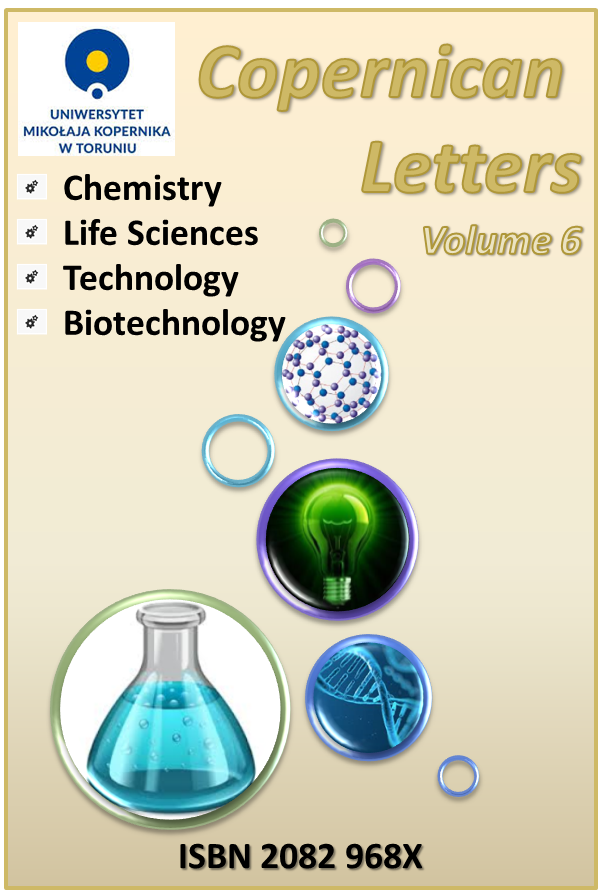Application of membrane techniques for the removal of micropollutants from water and wastewater
DOI:
https://doi.org/10.12775/CL.2015.004Keywords
membrane techniques, removal of inorganic micropollutants, removal of organic micropollutantsAbstract
A number of inorganic anions and heavy metals, microorganisms, natural organic matter, and organic micro-pollutants, among them disinfection by-products, pharmaceutical active compounds and endocrine disrupting compounds, have been found in potentially harmful concentrations in numerous water sources. The maximum permissible levels of these compounds, in drinking water and wastewaters discharged to environment, set by the WHO and a number of countries are very low (from µg/L to a few mg/L).
Several common treatment technologies, which are nowadays used for removal of inorganic and organic contaminants from natural water supplies, represent serious exploitation problems. Membrane processes such as RO and NF, UF and MF in integrated systems, Donnan dialysis and electrodialysis as well as MBR and liquid membranes, if properly selected, offer the advantage of producing high quality drinking water as well as purified wastewater which can be drained off to natural water sources.
High-pressure membrane techniques, i.e. RO and NF can be used for direct removal of inorganic and organic micropollutants, while low-pressure (MF and UF) in integrated systems, first of all with coagulation and adsorption and in MBR as well as after complexion with polymers or surfactants.
Processes with ion-exchange membranes are suitable for micropollutants having electrical charge. Because of that property they are used in many large scale applications including the separation of ions, desalination, removal of ionic species etc.
References
. Bodzek M., Konieczny K., Usuwanie zanieczyszczeń nieorganicznych ze środowiska wodnego metodami membranowymi, Wydawnictwo Seidel-Przywecki, Warszawa 2011, ISBN 978-83-60956-18-2.
. Bodzek M., Membrane technologies for the removal of micropollutants in water treatment, in: Basile A., Cassano A., Navin K. Rastogi (Eds.), Advances in Membrane Technologies for Water Treatment: Materials, Processes and Applications, Elsevier Science,Woodhead Publishing Ltd., Cambridge 2015, pp.465-515, ISBN 13: 9781782421214.
. Bodzek M., Konieczny, K., Membrane techniques in the removal of inorganic micropollutants from water environment – state of the art, Archives of Environmental Protection, 37(2) (2011) 15-29.
. Velizarov S., Crespo J.G., Reis M.A., Removal of inorganic anions from drinking water supplies by membrane bio/processes, Reviews in Environmental Science & Bio/Technology, 3 (2004) 361–380.
. Kołtuniewicz A.B., Drioli E., Membranes in clean technologies, Wiley-VchVerlag GmbH, Weinheim 2008, ISBN-13: 978-3-527-32007-3
. Wisniewski J., Electromembrane processes, in: Noworyta A., Trusek-Hołownia A. (Eds.), Membrane Separations, Argi, Wrocław 2001, pp.147179.
. Crespo J.G., Velizarov S.,Reis M.A., Membrane bioreactors for the removal of anionic micropollutants from drinking water, Current Opinion in Biotechnology, 15 (2004) 463–468.
. Bodzek M., Usuwanie metali ze środowiska wodnego za pomocą metod membranowych – stan wiedzy, Monografie Komitetu Inżynierii Środowiska Polskiej Akademii Nauk, 66 (2012) 305313.
. Bakalár T., Búgel M., Gajdošová, L., Heavy metal removal using reverse osmosis, Acta Montanistica Slovaca, 14 (2009) 250-253.
. Qdais H.A., Moussa H., Removal of heavy metals from wastewater by membrane processes: A comparative study, Desalination, 164 (2004) 105-110.
. Mehiguene K., Garba Y., Taha S., Gondrexon N., Dorange, G., Influence of operating conditions on the retention of copper and cadmium in aqueous solutions by nanofiltration: experimental results and modeling, Sep. Pur. Techn., 15 (1999)181-187.
. Korus I., Wykorzystanie ultrafiltracji wspomaganej polimerami do separacji jonów metali ciężkich, Wydawnictwo Politechniki Śląskiej, Gliwice 2012, ISBN: 978-83-7335-927-7.
. Zakrzewska-Trznadel G., Radioactive solution treatment by hybrid complexation-UF/NF process, J.Membr.Sci., 225 2003 25-39.
. Mavrov V., Nikolov N.D., Islam M.A. Nikolova J.D., An investigation on the configuration of inserts in tubular ultrafiltration module to control concentration polarization, J.Membr.Sci., 75 (1992)197-201.
. Owlad M., Aroua M.K., Daud W.A., Baroutian, S., Removal of hexavalent chromium -contaminated water and wastewater: A review, Water Air Soil Pollution, 200 (2009) 59–77.
. Bodzek M., Przegląd możliwości wykorzystania technik membranowych w usuwaniu mikroorganizmów i zanieczyszczeń organicznych ze środowiska, Inżynieria i Ochrona Środowiska,16(1) (2013) 5-37.
. Uyak V., Koyuncu I., Oktem I., Cakmakci M., Toroz I., Removal of trihalomethanes from drinking water by nanofiltration membranes, J. Hazard. Mater., 152 (2008) 789–794
. Chalatip R., Chawalit R., Nopawan R., Removal of haloacetic acids by nanofiltration, J. Environ. Sci., 21 (2009) 96–100.
. Kowalska M., Dudziak M., Bohdziewicz J., Biodegradacja kwasów halogenooctowych w bioreaktorze z poliamidową, enzymatyczną membraną ultrafiltracyjną, Inżynieria i Ochrona Środowiska, 14 (2011) 257-266.
. Bodzek M., Dudziak M., Luks–Betlej K., Application of membrane techniques to water purification. Removal of phthalates, Desalination, 162 (2004) 121 – 128.
. Dudziak M., Bodzek M., Removal of xenoestrogens from water during reverse osmosis and nanofiltration – effect of selected phenomena on separation of organic micropollutants, Architecture Civil Engineering Environment, 1(3) (2008) 95 – 101.
. Bodzek M., Dudziak M., Elimination of steroidal sex hormones by conventional water treatment and membrane processes, Desalination, 198, (2006) 24–32.
. Zuehlke S., Duennbier U., Lesjean B., Gnirss R., Buisson H., Long-term comparison of trace organics removal performances between conventional and membrane activated sludge processes, Water Environ. Res., 78 (2006) 2480–2486.
. Heberer T., Feldmann D., Removal of pharmaceutical residues from contaminated raw water sources by membrane filtration, in Pharmaceutical in the Environment, Berlin-Heidelberg, Springer 2008, pp.427-453, ISBN 978-3-540-74664-5.
. Snyder S., Adham S., Redding A., Cannon F., DeCarolis J., Oppenheimer J., Wert E., Yoon Y., Role of membranes and activated carbon in the removal of endocrine disruptors and pharmaceuticals, Desalination, 202 (2007) 156–181.
. Clara M., Strenn B., Gans O., Martinez, E., Kreuzinger N., Kroiss H., Removal of selected pharmaceuticals, fragrances and endocrine disrupting compounds in a membrane bioreactor and conventional wastewater treatment plants, Water Research, 39 (2005) 4797–4807.
. Radjenovic J., Petrovoc M., Barcelo D., Fate and distribution of pharmaceuticals in wastewater and sewage sludge of the conventional activated sludge (CAS) and advanced membrane bioreactor (MBR) treatment, Water Research, 43 (2009) 831-841.
. Kimura K., Toshima S., Amy G., Watanabe Y., Rejection of neutral endocrine disrupting compounds (EDCs) and pharmaceutical active compounds (PhACs) by RO membranes, J. Mem. Sci., 245 (2004 71–78.
Downloads
Published
How to Cite
Issue
Section
Stats
Number of views and downloads: 582
Number of citations: 0



